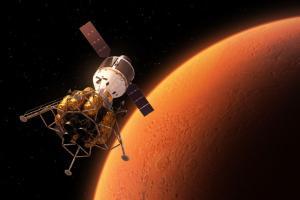In addition to addressing the life-on-Mars question, the mission will yield lessons that could pave the way for the arrival of astronauts as early as the 2030s

Image has been used for representational purpose only. Pic: iStock
Cape Canaveral: The biggest, most sophisticated Mars rover ever built - a car-size vehicle bristling with cameras, microphones, drills and lasers blasted off Thursday as part of an ambitious, long-range project to bring the first Martian rock samples back to Earth to be analysed for evidence of ancient life.
ADVERTISEMENT
NASA's Perseverance rode a mighty Atlas V rocket into the morning sky in the world's third and final Mars launch of the summer. China and the United Arab Emirates got a head start last week, but all three missions should reach the red planet in February after a journey of seven months and 300 million miles (480 million kilometers).
The plutonium-powered, six-wheeled rover will drill down and collect tiny geological specimens that will be brought home in about 2031 in a sort of interplanetary relay race involving multiple spacecraft and countries. The overall cost: more than USD 8 billion.
In addition to addressing the life-on-Mars question, the mission will yield lessons that could pave the way for the arrival of astronauts as early as the 2030s.
"There's a reason we call the robot Perseverance. Because going to Mars is hard," NASA Administrator Jim Bridenstine said just before liftoff. ¿It is always hard. It's never been easy. In this case, it's harder than ever before because we're doing it in the midst of a pandemic."
The US, the only country to safely put a spacecraft on Mars, is seeking its ninth successful landing on the planet, which has proved to be the Bermuda Triangle of space exploration, with more than half of the world's missions there burning up, crashing or otherwise ending in failure.
China is sending both a rover an orbiter.
The UAE, a newcomer to outer space, has an orbiter en route.
It's the biggest stampede to Mars in spacefaring history. The opportunity to fly between Earth and Mars comes around only once every 26 months when the planets are on the same side of the sun and about as close as they can get.
Launch controllers wore masks and sat spaced apart at the Cape Canaveral control center because of the coronavirus outbreak, which kept hundreds of scientists and other team members away from Perseverance's liftoff.
"There's nowhere else I'd rather be," said Alex Mather, the 13-year-old Virginia schoolboy who proposed the name Perseverance in a NASA competition and traveled to Cape Canaveral for the launch.
If all goes well, the rover will descend to the Martian surface on Feb 18, 2021, in what NASA calls seven minutes of terror, in which the craft goes from 12,000 mph (19,300 kph) to a complete stop, with no human intervention whatsoever. It is carrying 25 cameras and a pair of microphones that will enable Earthlings to vicariously tag along.
Perseverance will aim for treacherous unexplored territory: Jezero Crater, a dusty expanse riddled with boulders, cliffs, dunes and possibly rocks bearing signs of microbes from what was once a lake more than 3 billion years ago. The rover will store half-ounce (15-gram) rock samples in dozens of super-sterilized titanium tubes.
It also will release a mini helicopter that will attempt the first powered flight on another planet, and test out other technology to prepare the way for future astronauts, including equipment for extracting oxygen from Mars' thin carbon-dioxide atmosphere.
The plan is for NASA and the European Space Agency to launch a dune buggy in 2026 to fetch the rock samples, along with a rocket ship that will put the specimens into orbit around Mars. Then another spacecraft will capture the orbiting samples and bring them home.
 Subscribe today by clicking the link and stay updated with the latest news!" Click here!
Subscribe today by clicking the link and stay updated with the latest news!" Click here!






